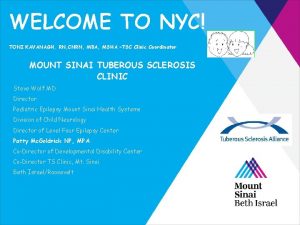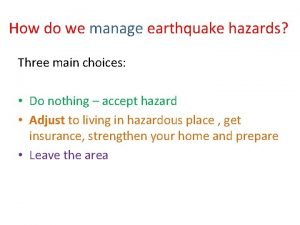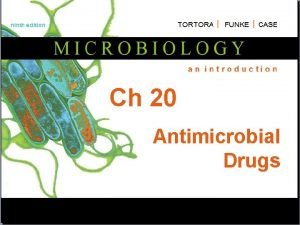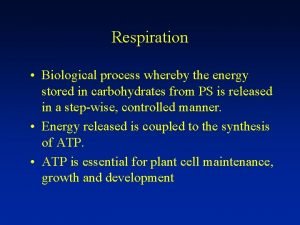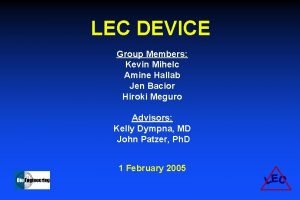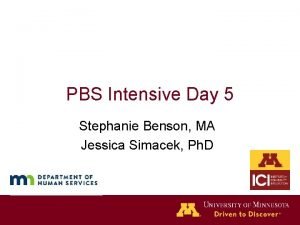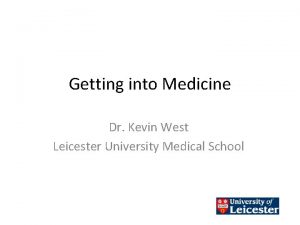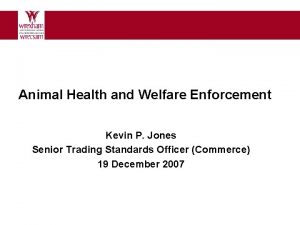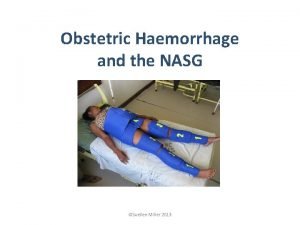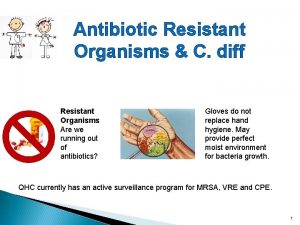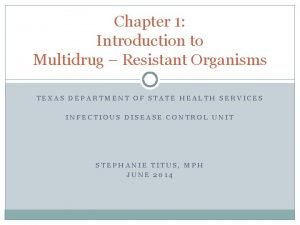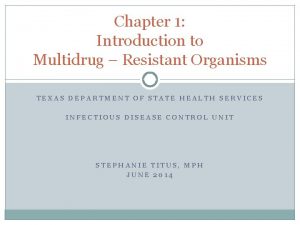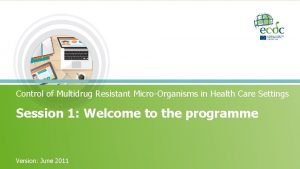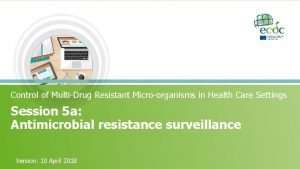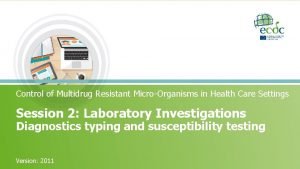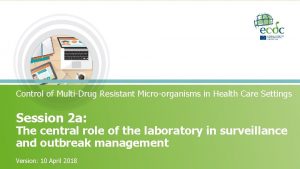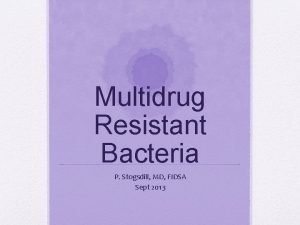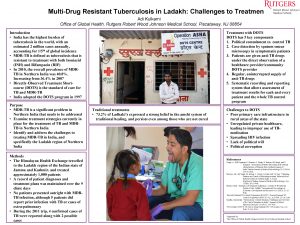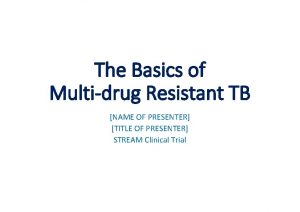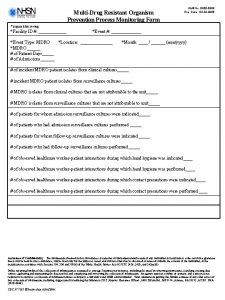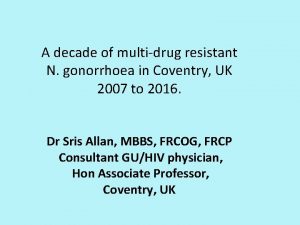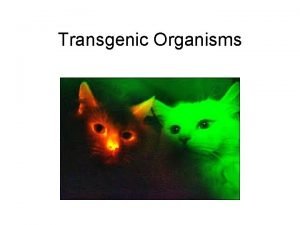MultiDrug Resistant Organisms Kevin T Kavanagh MD MS












































































- Slides: 76

Multi-Drug Resistant Organisms Kevin T. Kavanagh, MD, MS Health Watch USA Somerset Community College March 13, 2018

Multi-Drug Resistant Organisms Bacteria which are resistant to three or more classes of antibiotics ØAminoglycosides (gentamycin, tobramycin), Øβ-lactams (cephalosporins, penicillin, methicillin), ØCarbapenems, ØFluoroquinolones (ciprofloxacillin, levofloxacin) and ØTetracyclines

Lecture Topics • • • Incidence & Cost of MDRO Infections Antibiotic Overutilization Agricultural Usage of Antibiotics Types of Organisms -- MRSA -- Incidence -- Prevention -- C. Diff -- Incidence -- Prevention -- CRE -- Incidence -- Prevention Each year in the United States, at least 2 million people become infected with bacteria that are resistant to antibiotics and at least 23, 000 people die each year as a direct result of these infections. -- Association for Professionals in Infection Control and Epidemiology http: //cqrcengage. com/apic/antibioticresistance Facility and Health Department Coordination

Incidence & Cost v. These infections will transform healthcare and not in a good way. Once treatable disease will become death sentences. ØPatients Needing Organ Transplantation. ØChemotherapy for Cancer. ØImmunosuppression for Autoimmune Disease & Asthma. ØImmunocompromised Patients Such as Diabetics. ØEven Surgeries Will Have Much Greater Risk of Complications.

Cost of Antibiotic Resistant Infections • March 2009: “…the overall annual direct medical costs of HAI to U. S. hospitals ranges from …. . $35. 7 billion to $45 billion (after adjusting to 2007 dollars using the CPI for inpatient hospital services). The Direct Medical costs of Healthcare-Associated Infections in U. S. Hospitals and the Benefits of Prevention. Author – R. Douglas Scott II, Economist Division of Healthcare Quality Promotion National Center for Preparedness, Detection, and Control of Infectious Diseases Coordinating Center for Infectious Diseases Centers for Disease Control and Prevention March 2009 https: //www. cdc. gov/hai/pdfs/hai/scott_costpaper. pdf

“For countries in the OECD, the cumulative (multi-year) loss of economic output by 2050 will amount to between USD 20 and 35 trillion” Source: Antimicrobial Resistance: Tackling a crisis for the health and wealth of nations. The Review on Antimicrobial Resistance, HM Government, Welcome Trust. Chaired by Jim O’Neill

Incidence & Cost • The damaging effects of antimicrobial resistance (AMR) are already manifesting themselves across the world. Antimicrobial-resistant infections currently claim at least 50, 000 lives each year across Europe and the US alone, with many hundreds of thousands more dying in other areas of the world. But reliable estimates of the true burden are scarce. Antimicrobial Resistance: Tackling a crisis for the health and wealth of nations. HM Government, Welcome Trust. The Review on Antimicrobial Resistance, Chaired by Jim O’Neill. Dec. 2014 https: //amr-review. org/sites/default/files/AMR%20 Review%20 Paper%20%20 Tackling%20 a%20 crisis%20 for%20 the%20 health%20 and%20 wealth%20 of%20 nations_1. pdf

Nursing Homes - HAI A large proportion of Healthcare Associated Infections (HAI) are Drug Resistant. • “…there are between 1. 6 and 3. 8 million HAIs [health care- acquired infections] in nursing homes every year. Annually, these infections result in an estimated 150, 000 hospitalizations, 388, 000 deaths, and between $673 million and $2 billion dollars in additional healthcare costs (Castle, et al. Nursing home deficiency citations for infection control, American Journal of Infection Control, May 2011; 39, 4). ” Proposed CMS Nursing Home Regulations: Docket ID: CMS-2015 -0083. Agency: Centers for Medicare Medicaid Services (CMS)

Antimicrobial Resistance: Tackling a crisis for the health and wealth of nations. The Review on Antimicrobial Resistance, Chaired by Jim O’Neill

Yearly Deaths to AMR by 2050 Antimicrobial Resistance: Tackling a crisis for the health and wealth of nations. HM Government, Welcome Trust. The Review on Antimicrobial Resistance, Chaired by Jim O’Neill https: //amr-review. org/sites/default/files/AMR%20 Review%20 Paper%20%20 Tackling%20 a%20 crisis%20 for%20 the%20 health%20 and%20 wealth%20 of%20 nations_1. pdf

Antibiotic Overutilization

Antibiotic Usage – United States The Center For Disease Dynamics, Economics & Policy (CDDEP): https: //resistancemap. cddep. org/Antibiotic. Use. php

Antibiotic Usage – United States

Antibiotic Usage – Kentucky The Center For Disease Dynamics, Economics & Policy https: //resistancemap. cddep. org/Country. Page. Sub. php? country. Id= 38&country=United+States

Antibiotic Usage - Kentucky

Colistin, The last line of Defense Same mechanism of resistance: 1) Polymyxin B 2) Polymyxin D (Colistin)

Agricultural Usage of Antibiotics

Agriculture Usage of Antibiotics 70% of antibiotics used in the United States are Used in Agriculture. Ø 95% are used in the food and water of animals. ØApproximately 96% are sold over the counter. Antibiotics and Animal Agriculture: A Primer. Why are antibiotics used in animal agriculture, and what can be done to ensure their appropriate use? A fact sheet from the PEW charitable trusts. Jan. 2017 http: //www. pewtrusts. org/en/research-and-analysis/fact-sheets/2016/12/antibiotics-and-animalagriculture-a-primer U. S. Food and Drug Administration, 2014 Summary Report on Antimicrobials Sold or Distributed for Use in Food-Producing Animals (2015), http: //www. fda. gov/downloads/For. Industry/User. Fees/Animal. Drug. User. Fee. Act. ADUFA/UCM 476258. pdf.

Agriculture – MDRO Spread Importance in Human Infections. Ø Spread to the environment. ØOn food processed, for example chicken contaminated with Salmonella and/or Campylobacter. ØMounting evidence of direct spread of MDROs from animals to humans. However, the percentage of human infections caused by this source has not been determined. Consumer Union: The Overuse of Antibiotics in Food Animals Threatens Public Health. http: //consumersunion. org/news/the-overuse-of-antibiotics-infood-animals-threatens-public-health-2/

Common Multi-Drug Resistant Organisms

Epidemiology and Control Are Different Depending Upon the Organism • • • Methicillin-resistant Staphylococcus aureus (MRSA) -- Administration and Hospital Staff Dependent. Environmental Staff & Nursing. Clostridium difficile (C. Diff. ) -- Physician Dependent, Antibiotic Stewardship can prevent activation. -- Screening has also been found to be beneficial. Carbapenem-resistant Enterobacteriaceae (CRE) -- Screening all contacts in both hospital and community. Coordinated approach with Health Dept. of Paramount Importance.

Epidemiology and Control Are Different Depending Upon the Organism

Mechanisms of Resistance ØProduces Enzyme To Breakdown Antibiotics. ØMulti-Drug Efflux Pumps ØWall Barriers to Penetration.

Methicillin-resistant Staphylococcus aureus (MRSA)

MRSA in The United States • MRSA causes all too common skin and soft tissue infection.

MRSA in The United States Kavanagh KT, et. al. The incidence of MRSA infections in the United States. Is a more comprehensive tracking system needed? Antimicrobial Resistance and Infection Control. April 7, 2017.

MRSA in Kentucky – CDC - HAI CDC: .

MRSA in Kentucky – NHSN - HAI State Rankings MRSA Bloodstream Infections – Hospital Associated Ranking State Measure Name Measure ID SIR Score 44 NV MRSA HAI_5_SIR 1. 115 45 KY MRSA HAI_5_SIR 1. 173 46 DC MRSA HAI_5_SIR 1. 183 47 WV MRSA HAI_5_SIR 1. 199 48 OK MRSA HAI_5_SIR 1. 254 49 AR MRSA HAI_5_SIR 1. 264 50 TN MRSA HAI_5_SIR 1. 267 51 LA MRSA HAI_5_SIR 1. 385 NHSN Data for Acquisition Dates: 4/1/2016 3/31/2017

MRSA in Kentucky – NHSN - HAI KY Hospital Rankings MRSA Bloodstream Infections – HAI Ø 27 of 92 hospitals had calculated SIR Scores. Ø One hospital was statistically better than the National Benchmark (NB). Ø Four hospitals were statistically worse than the National Benchmark (NB). Rank Hospital 4 BAPTIST HEALTH LOUISVILLE 18 UNIVERSITY OF KENTUCKY HOSPITAL Measure ID LOUISVILLE MRSA HAI_5_SIR Score 0. 268 Better Than NB LEXINGTON MRSA HAI_5_SIR 1. 378 Worse than NB 20 NORTON HOSPITAL / NORTON HEALTHCARE LOUISVILLE MRSA PAVILION / NOR 21 UNIVERSITY OF LOUISVILLE HOSPITAL LOUISVILLE MRSA 26 LAKE CUMBERLAND REGIONAL HOSPITAL SOMERSET MRSA HAI_5_SIR 1. 639 Worse than NB HAI_5_SIR 1. 703 2. 541 Worse than NB NHSN Data for Acquisition Dates: 4/1/2016 3/31/2017

Will The Epidemic Reverse • Denmark Experience – In Beginning Easier To Reverse “The frequency of MRSA rose to 15% in the years 1967 through 1971 but decreased to 0. 2% in 1984. Since 1984, only 0. 2% of the Danish S aureus population has been MRSA, and imported MRSA strains have been prevented from spreading. “ Rosdahl VT, Knudsen AM. The decline of methicillin resistance among Danish Staphylococcus aureus strains. Infect Control Hosp Epidemiol. 1991 Feb; 12(2): 83 -8.

MRSA Prevention Two Methodologies are in Use ØSurveillance and Screening ØUnit or Facility Wide Daily Bathing with Chlorhexidine Reuters News Service: “In 2009, the federal government launched a campaign to reduce bloodstream infections by the notorious superbug methicillin-resistant Staphylococcus aureus (MRSA) in hospital patients 25 percent by 2013. That failed. The new goal: Halve infection rates by 2020. “ Nelson DJ, Mc. Neill R. Money from infection-control industry muddies research into beating back superbugs Reuters News Service. Apr. 7, 2017. http: //www. reuters. com/investigates/specialreport/usa-superbugs-research/

MRSA Prevention Surveillance and Screening ØThe U. S. Veterans Administration ØThe United Kingdom

MRSA Prevention - VA • The VA has also seen a dramatic reduction in MRSA infections in 127 reporting acute care hospitals. From October 2007 to October 2015, healthcare-associated MRSA infection rates dropped 87. 0% in ICUs and 80. 1% in non-ICU patient areas, achieving an incidence of 0. 147 and 0. 090 infections per 1, 000 patient days, respectively. In long term care facilities the VA reports MRSA infection reductions of 49. 4% from July 2009 to September 2015. 12 Kavanagh KT, Abusalem S, Calderon LE. The incidence of MRSA infections in the United States. Is a more comprehensive tracking system needed? Antimicrobial Resistance and Infection Control. April 7, 2017. 6: 34 DOI: 10. 1186/s 13756 -017 -0193 -0 https: //aricjournal. biomedcentral. com/articles/10. 1186/s 13756 -017 -0193 -0

MRSA Prevention - VA Kavanagh KT, Abusalem S, Calderon LE. The incidence of MRSA infections in the United States. Is a more comprehensive tracking system needed? Antimicrobial Resistance and Infection Control. April 7, 2017. 6: 34 DOI: 10. 1186/s 13756 -017 -0193 -0 https: //aricjournal. biomedcentral. com/articles/10. 1186/s 13756 -017 -0193 -0

MRSA Prevention – United Kingdom Even a Large Scale Epidemic Can Be Reversed. The English Experience Otter J. The English MRSA Miracle. Micro Blog. Your window to the world of healthcare microbiology and epidemiology; by Jon Otter and Saber Yezli Mar. 8, 2015 from https: //reflectionsipc. com/2015/03/03/the-english-mrsa-miracle/

MRSA Prevention – United Kingdom Screening of High Risk Patients ØAll elective surgical patients ØAll emergency admissions ØCritical care (including intensive care and high-dependency units) ØPre-operative patients in certain surgical specialties ØEmergency orthopaedic and trauma admissions ØRenal medicine ØAll patients previously known to be MRSA positive ØOncology/chemotherapy inpatients ØPatients admitted from high-risk settings Screening for Meticillin-resistant Staphylococcus aureus (MRSA) colonisation: A strategy for NHS trusts: a summary of best practice. 2006 (Archived Jan 23, 2013) http: //webarchive. nationalarchives. gov. uk/20130123191323/http: //www. dh. gov. uk/prod _consum_dh/groups/dh_digitalassets/@dh/@en/documents/digitalasset/dh_063187. pdf

MRSA Prevention – United Kingdom • The logical conclusion of risk factor assessments and the results of modelling studies is that the most appropriate approach to the reduction in MRSA carriage in the population, and resultant MRSA infections, is the universal screening of all admissions to hospital (either at pre-admission clinics for elective admissions or immediately on admission for emergency admissions). Screening for Meticillin-resistant Staphylococcus aureus (MRSA) colonisation: A strategy for NHS trusts: a summary of best practice. 2006 (Archived Jan 23, 2013) http: //webarchive. nationalarchives. gov. uk/20130123191323/http: //www. dh. gov. uk/prod _consum_dh/groups/dh_digitalassets/@dh/@en/documents/digitalasset/dh_063187. pdf

MRSA - Chlorohexidine Bathing Popularized by the Reduce MRSA Study. Research Integrity Questions Regarding: ØSpinning of Data ØChanging of Metrics ØUse of Surrogate Endpoints Huang SS, Septimus E, Kleinman K, et al. Targeted versus universal decolonization to prevent ICU infection. N Engl J Med. 2013; 368(24): 2255 -65. doi: 10. 1056/NEJMoa 1207290. Epub 2013 May 29

Spinning of Data – REDUCE MRSA Study ØAbstract: “In routine ICU practice, universal decolonization was more effective than targeted decolonization or screening and isolation in reducing rates of MRSA clinical isolates and bloodstream infection from any pathogen. ” ØBut “any pathogen” refers to a composite category which was added after the trial completion date (registered on clinical trials. gov) and whose effects were largely based on Yeast and Consensual Bacteria. Huang SS, Septimus E, Kleinman K, et al. Targeted versus universal decolonization to prevent ICU infection. N Engl J Med. 2013; 368(24): 2255 -65. doi: 10. 1056/NEJMoa 1207290. Epub 2013 May 29

Chlorhexidine – Health Watch USA Ø Kavanagh KT, Saman DM, Yu Y. A Perspective on How the United States Fell behind Northern Europe in the Battle against Methicillin-Resistant Staphylococcus aureus. Antimicrob Agents Chemother. 2013 Dec; 57(12): 5789 -91. doi: 10. 1128/AAC. 01839 -13. Epub 2013 Oct 7. PMID: 24100502 http: //aac. asm. org/content/57/12/5789. long Ø Kavanagh KT, Calderon LE, Saman DM, Abusalem SK. The use of surveillance and preventative measures for methicillin-resistant staphylococcus aureus infections in surgical patients. Antimicrob Resist Infect Control. 2014 May 14; 3: 18. e. Collection 2014. PMID: 24847437 http: //www. aricjournal. com/content/3/1/18 Ø Kavanagh KT, Calderon LE and Saman DM Viewpoint: a response to “Screening and isolation to control methicillin-resistant Staphylococcus aureus: sense, nonsense, and evidence” Antimicrobial Resistance and Infection Control 2015, 4: 4 (5 February 2015) http: //www. aricjournal. com/content/4/1/4 Ø Kavanagh KT, Tower SS, Saman DM. A perspective on the principles of integrity in infectious disease research. Journal of Patient Safety. Published Online Mar. 24, 2016. PMID 27010326 http: //journals. lww. com/journalpatientsafety/Fulltext/2016/06000/A_Perspective _on_the_Principles_of_Integrity_in. 1. aspx

MRSA - Chlorhexidine Bathing Reuters News Service: “Since then, Sage has provided funding and millions of dollars in wipes for studies by Weinstein and his colleagues. And in that time, Weinstein and his colleagues have published 11 articles on six trials that endorse daily washing of patients with Sage’s patented wipes — an “off-label” use, as the U. S. Food and Drug Administration (FDA) has approved the wipes only for cleaning patients before surgery. ”

MRSA - Chlorhexidine Bathing Reuters News Service: “…. a $1 million donation from the family foundation of Sage’s founder, Vincent W. Foglia. The money was earmarked for research by the senior scientist on the study, Dr Robert A. Weinstein, an infectious-disease specialist at Rush. . ”

MRSA - Chlorhexidine Bathing Helio Infectious Disease News: “We found that, in general units outside the ICU, only patients with central lines and other medical devices derived a benefit from chlorhexidine bathing, researcher Susan S. Huang, MD, MPH, . ” Oct. 7, 2017: https: //www. healio. com/infectiousdisease/mrsa/news/online/{91 bded 5 c-d 4 c 7 -426 d-97 f 7 -b 42169472618}/dailychlorhexidine-does-not-reduce-mrsa-vre-in-lower-risk-patients

MRSA - Chlorhexidine Bathing LA Times: “Dr. Susan Huang, the hospital’s infection control expert, had a plan. The strategy — which she had promoted so successfully that most U. S. hospitals now use it — included bathing all infants in the ICU with a powerful disinfectant, and swabbing inside their noses with an antibiotic. But this time, the plan failed. . ” Peterson M. LA Times May 16, 2017 http: //www. latimes. com/business/la-fi-uci-infant-outbreak 20170515 -story. html

MRSA - Chlorhexidine Bathing May be fueling the epidemic of CRE by stimulation of Multi-Drug Efflux Pumps

Clostridium difficile (C. Diff)

Clostridium difficile • C. Diff can cause a severe and life threatening GI infection. • Forms Spores – Very hard to treat and infections return 20% of the time. • 95% of infections are linked to medical care (hospitals 25%, nursing homes, outpatient care 75%). https: //www. cdc. gov/HAI/organism s/cdiff/Cdiff_infect. html https: //www. cdc. gov/hai/organisms /cdiff-patient. html

Clostridium difficile • C. difficile – was estimated to cause almost half a million infections in the United States in 2011, and 29, 000 died within 30 days of the initial diagnosis. • Cost estimated to be 1 billion dollars annually. • Rates increased 4 X between 2000 and 2007. NOT GOING DOWN https: //www. cdc. gov/HAI/organism s/cdiff/Cdiff_infect. html https: //www. cdc. gov/hai/organisms /cdiff-patient. html

Clostridium difficile – PA Hospitals • • In FY 2017, 495 admissions for CDI—relatively steady since FY 2008. 20% developed the condition in the hospital. Mortality Declining. “In-hospital mortality dropped 42% (from 9. 7% to 5. 7% Readmission rates dropped 14%, from 32. 9% to 28. 2%. ” Patients admitted with CDI had a 5% mortality. Acquired CDI in the hospital was associated with a 8. 5 mortality. Ref: PHC 4 http: //www. phc 4. org/reports/rese archbriefs/cdi/17/nr 030118. htm

Clostridium difficile in KY– CDC - HAI CDC: .

Clostridium difficile in KY – NHSN - HAI State Rankings Clostridium Difficile Infections – Hospital Associated Ranking State Measure Name Measure ID SIR Score 1 AL C. Difficile HAI_6_SIR 0. 623 2 ME C. Difficile HAI_6_SIR 0. 68 3 ID C. Difficile HAI_6_SIR 0. 692 4 MS C. Difficile HAI_6_SIR 0. 718 5 FL C. Difficile HAI_6_SIR 0. 769 6 SC C. Difficile HAI_6_SIR 0. 77 7 HI C. Difficile HAI_6_SIR 0. 779 8 AR C. Difficile HAI_6_SIR 0. 786 9 KY C. Difficile HAI_6_SIR 0. 799 NHSN Data for Acquisition Dates: 4/1/2016 3/31/2017

Clostridium difficile in KY– NHSN - HAI Rank Hospital 1 8 11 12 14 16 17 19 21 24 26 28 29 30 31 WHITESBURG ARH HOSPITAL GREENVIEW REGIONAL HOSPITAL METHODIST HOSPITAL HAZARD ARH REGIONAL MEDICAL CENTER HIGHLANDS REGIONAL MEDICAL CENTER HARDIN MEMORIAL HOSPITAL BAPTIST HEALTH PADUCAH OUR LADY OF BELLEFONTE HOSPITAL OWENSBORO HEALTH REGIONAL HOSPITAL LOURDES HOSPITAL BAPTIST HEALTH MADISONVILLE KING'S DAUGHTERS' MEDICAL CENTER THE MEDICAL CENTER AT BOWLING GREEN UNIVERSITY OF KENTUCKY HOSPITAL ST ELIZABETH MEDICAL CENTER NORTH 57 59 EPHRAIM MCDOWELL REGIONAL MED. CTR. DANVILLE OWENSBORO HEALTH MUHLENBERG GREENVILLE COMMUNITY HOSPITAL FLAGET MEMORIAL HOSPITAL BARDSTOWN 60 Ø Ø Ø WHITESBURG BOWLING GREEN HENDERSON HAZARD PRESTONSBURG ELIZABETHTOWN PADUCAH ASHLAND OWENSBORO PADUCAH MADISONVILLE ASHLAND BOWLING GREEN LEXINGTON EDGEWOOD Measure ID SIR Score C. Diff C. Diff HAI_6_SIR HAI_6_SIR HAI_6_SIR HAI_6_SIR 0 0. 149 0. 289 0. 291 0. 332 0. 453 0. 467 0. 473 0. 503 0. 536 0. 611 0. 639 0. 652 0. 766 0. 77 Better than NB Better than NB Better than NB Better than NB C. Diff HAI_6_SIR 1. 482 2. 722 Worse than NB C. Diff HAI_6_SIR 3. 529 Worse than NB 60 of 92 hospitals had calculated SIR Scores. 15 hospitals was statistically better than the National Benchmark. 3 hospitals were statistically worse than the National Benchmark. NHSN Data for Acquisition Dates: 4/1/2016 3/31/2017

Antibiotic Overutilzation • Fluoroquinolones FDA: “The U. S. Food and Drug Administration is advising that the serious side effects associated with fluoroquinolone antibacterial drugs generally outweigh the benefits for patients with acute sinusitis, acute bronchitis, and uncomplicated urinary tract infections who have other treatment options. For patients with these conditions, fluoroquinolones should be reserved for those who do not have alternative treatment options. ” July 26, 2016. https: //www. fda. gov/Drugs/Drug. Saf ety/ucm 500143. htm

Antibiotic Usage – Kentucky The Center For Disease Dynamics, Economics & Policy https: //resistancemap. cddep. org/Country. Page. Sub. php? country. Id= 38&country=United+States

Carbapenem-resistant Enterobacteriaceae (CRE)

Carbapenem-resistant Enterobacteriaceae • Severe GI Infections with a 50% fatality rate if enters the blood. • Colistin – Very toxic antibiotic is the last line of defense. • However, becoming resistant to this antibiotic. Ref: CDC

Carbapenem-resistant Enterobacteriaceae • There is no National Reporting System • Possible to reduce CRE infections by 70% over 5 years if facilities coordinate to protect patients – CDC.

CRE - Prevention “Each institution will need to carefully choose among the available screening methodologies to support their active surveillance program, and lack of ability to implement molecular testing should not otherwise prevent pursuit of aggressive CRE control efforts using existing culture techniques. ” Ref: Carbapenem-Resistant Enterobacteriaceae (CRE) Control and Prevention Toolkit. - AHRQ http: //www. ahrq. gov/cretoolkit

• Identification of all epidemiologically related contacts (screening). • Contact Isolation for carriers and those with infections.

CRE are nightmare bacteria CRE in 2002 to 2012: “During the first six months of 2012 4. 6% of hospitals reported one or more infections. 3. 9% in short stay hospitals and 17. 8% long term facilities. 2 CRE Klebsiella cultures positive for CRE increased from 0. 1% to 4. 5% between 2002 and 2010. 4 Vital Signs: Carbapenem-Resistant Enterobacteriaceae. MMWR Morbidity and Mortality Weekly Report. March 5, 2013. Vol. 62 http: //www. cdc. gov/mmwr/preview/mmwrhtml/mm 6209 a 3. htm? s_cid=mm 6209 a 3_w CDC News Release. Tuesday, March 5 th, 2013. http: //www. cdc. gov/media/releases/2013/p 0305_deadly_bacteria. html Braykov NP, Eber MR, Klein EY, Morgan DJ, Laxminarayan R. Trends in resistance to carbapenems and third-generation cephalosporins among clinical isolates of Klebsiella pneumoniae in the United States, 1999 -2010. Infect Control Hosp Epidemiol. 2013 Mar; 34(3): 259 -68. doi: 10. 1086/669523. Epub 2013 Jan 23. http: //www. ncbi. nlm. nih. gov/pubmed/23388360

CRE in 2001 to 2013 • “Nationally, the CDC issued warnings last year about CRE, saying the bacteria spread from one medical facility in 2001 to numerous facilities in 46 states in 2013. CDC Director Tom Frieden said, "Our strongest antibiotics don't work, and patients are left with potentially untreatable infections. “ Unger L. Doctors fear growing hospital superbug. Courier Journal. Aug. 5, 2014. https: //www. courier-journal. com/story/life/wellness/health/2014/08/04/doctors-feargrowing-hospital-superbug/13569933/

CRE Outbreak in Louisville, KY - 2013 • “Kavanagh said it’s important that outbreaks be made public, partly because patients often go from one health care location to another “This is a huge problem, ” he said. “It’s not something one hospital can control. In Kentucky, health care sites must report “outbreaks” of greater-than-expected numbers of cases, leaving it to them to interpret what that means. But Kavanagh and state Rep. Tom Burch, D-Louisville, are calling for a new rule that hospitals report all CRE cases to the state. Burch says he plans to introduce a bill on mandatory public reporting in next year’s General Assembly. ” Ungar L. Kindred had 40 CRE cases. Courier Journal, April 16, 2013.

CRE in 2012 to 2013 • Study finds an incidence of 2. 93 CRE cases per 100, 000 people over a two year period. Equates to 4500 People a Year. Data acquisition dates 2012 -2013. Guh AY, Bulens SN, Mu Y, Jacob JT, et al. Epidemiology of Carbapenem-Resistant Enterobacteriaceae in 7 US Communities, 2012 -2013. JAMA. 2015 Oct 5: 1479 -1487. doi: 10. 1001/jama. 2015. 12480. [Epub ahead of print]

CRE in 2014 - Kentucky Deptartment for Public Health

CRE in 2016 – HARP-DC

CRE in 2016 HARP-DC

Dangerous CRE Outbreak In Kentucky. Health Department Working With Healthcare Facilities • A rare form of resistance found in 8 patients, in 4 different types of bacteria, in two different wards. • Demonstrates that the transmission of resistance between different types of bacteria is clinically important. • No patient developed an infection.

Dangerous CRE Outbreak In Kentucky. Health Department Working With Healthcare Facilities • A rare form of resistance found in 8 Bacterial Conjugation patients, in 4 different types of bacteria, in two different wards. • Demonstrates that the transmission of resistance between different types of bacteria is clinically important. • No patient developed an infection.

Dangerous CRE Outbreak In Kentucky. We hear about it over a year later. "On August 11, 2016, two Klebsiella pneumoniae carbapenemase (KPC)– producing CP-CRE isolates from clinical cultures were reported from patients hospitalized at a rural, community hospital in Kentucky; CRE had not been identified previously at this facility. During the next 4 months, an additional 21 CRE isolates were identified from facility patients, resulting in a total of 23 isolates, including 17 K. pneumoniae, five Escherichia coli, and one Enterobacter cloacae isolate. Seventeen (74%) of these isolates were identified through patient screening cultures; the rest were from clinical cultures. "

Coordinated Approach To Prevention

Kentucky – MDRO Reporting Regulation Healthcare associated infection surveillance KAR 902. 20 Ø Defines an Outbreak “HAI Outbreak” means (a) The occurrence of two (2) or more HAIs that are epidemiologically linked or connected by person, place, or time; or (b) A single case of an HAI not commonly diagnosed such as a postsurgical group A Streptococcus infection or healthcare-associated Legionella infection. Ø Covers All Types of Facilities ““Health facility” means: (a) A facility licensed under 902 KAR Chapter 20 and required by the Centers for Medicare and Medicaid Services (CMS) to report an HAI event or healthcare personnel influenza vaccination information to CMS using the National Healthcare Safety Network; or (b) A facility licensed under KRS Chapter 216 B. ”

Kentucky – MDRO Reporting Regulation Healthcare associated infection surveillance KAR 902. 20 Ø Following diseases shall be electronically reported to the Kentucky Department for Public within five (5) business days: (a) Vancomycin-intermediate Staphylococcus aureus (VISA), (b) Vancomycin-resistant Staphylococcus aureus (VRSA) (c) Methicillin-resistant Staphylococcus aureus (MRSA) (d) Vancomycin-resistant Enterococcus species (VRE) (e) Clostridium difficile (C. difficile) identified from a positive laboratory test result for a C. difficile toxin A or B, (f) Carbapenem-resistant Enterobacteriaceae (CRE) (g) Extended–spectrum beta-lactamase Gram negative organisms (ESBL); (h) Multidrug-resistant – Acinetobacter - Non-susceptibility (resistant or intermediate) to at least one (1) agent in at least three (3) antimicrobial classes.

• No single facility or facility type can solve this problem. It takes a coordinated approach.

CDC: What Is Needed • Independent Approach – Not Enough • Coordinated Approach – What is Needed. Facilities and public health authorities share information and implement shared infection control actions to stop spread of germs from facility to facility. Vital Signs. Aug. 4, 2015 Center for Disease Control and Prevention

Vital Signs. Aug. 4, 2015 Center for Disease Control and Prevention

 Member of the same species
Member of the same species Multi and unicellular organisms
Multi and unicellular organisms Welcome to digital world
Welcome to digital world Chandra kavanagh
Chandra kavanagh Patrick kavanagh in memory of my mother
Patrick kavanagh in memory of my mother Chandra kavanagh
Chandra kavanagh Shirley kavanagh
Shirley kavanagh Toni kavanagh
Toni kavanagh Skyscraper pendulum
Skyscraper pendulum Design of seismic-resistant steel building structures
Design of seismic-resistant steel building structures Fiber optic cable rodent protection
Fiber optic cable rodent protection Fire resistant cable thai yazaki
Fire resistant cable thai yazaki Resistant materials tools
Resistant materials tools Puncture resistant container
Puncture resistant container Glycopeptide
Glycopeptide Kyloc usmc
Kyloc usmc Flame resistant lab coat amazon
Flame resistant lab coat amazon Collision resistant hash function
Collision resistant hash function Arc resistant switchgear
Arc resistant switchgear Define temper evident packaging
Define temper evident packaging Spill resistant vacuum breaker
Spill resistant vacuum breaker Resistant ovary syndrome definition
Resistant ovary syndrome definition Collision resistant hash function
Collision resistant hash function Smrf
Smrf Packaging
Packaging Cyanide-resistant respiration slideshare
Cyanide-resistant respiration slideshare Kevin ahern
Kevin ahern Kevin metnick
Kevin metnick Kevin murphy nasa
Kevin murphy nasa Bitonic tsp
Bitonic tsp Kevin fox 20/20
Kevin fox 20/20 Kevin mihelc
Kevin mihelc Kevin hinckley
Kevin hinckley Chloe howlett
Chloe howlett Kevin grittner
Kevin grittner Dead by daylight
Dead by daylight Kevin thompson nsf
Kevin thompson nsf Kevin 360 insecticide
Kevin 360 insecticide Cuesta college accreditation
Cuesta college accreditation Hold fast kevin major
Hold fast kevin major Kevin harville
Kevin harville Kevin ferraro
Kevin ferraro Agilent erp
Agilent erp Kevin stoodley
Kevin stoodley Oracle fail safe
Oracle fail safe Kevin curtin at&t
Kevin curtin at&t Kevin bunting
Kevin bunting Kevin pepitone
Kevin pepitone Kevin benson md
Kevin benson md Dr kevin west
Dr kevin west Kevin kline sql
Kevin kline sql Kevin p jones
Kevin p jones Kevin theissen
Kevin theissen Lbo analysis
Lbo analysis Kevin bossuet
Kevin bossuet Kevin guzzo
Kevin guzzo Kevin 380
Kevin 380 Kevin brunner
Kevin brunner Kevin jobson
Kevin jobson Kevin coset
Kevin coset Jerome kevin and seth shared a submarine sandwich
Jerome kevin and seth shared a submarine sandwich Kevin demott
Kevin demott Kevin gensler
Kevin gensler Dit kevin st
Dit kevin st Dr kevin doody
Dr kevin doody Northview junior high school
Northview junior high school Kevin nasg
Kevin nasg The art of deception by kevin mitnick
The art of deception by kevin mitnick Kevin leehey
Kevin leehey Kevin howald
Kevin howald Kevin klues
Kevin klues Kevin price chicago
Kevin price chicago Judy cato
Judy cato Margareta colangelo
Margareta colangelo Kevin raubenolt
Kevin raubenolt Sndusrmsg
Sndusrmsg Kevin erler
Kevin erler







